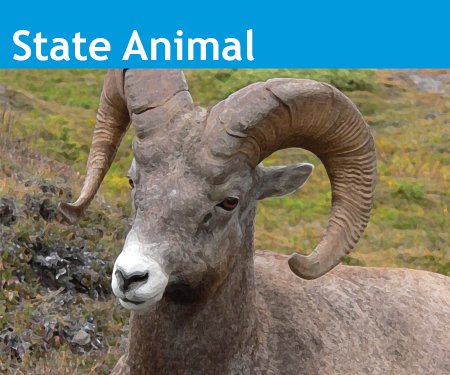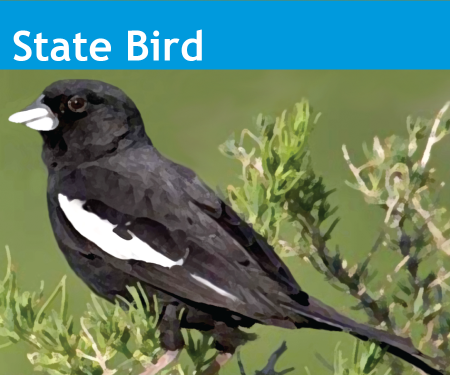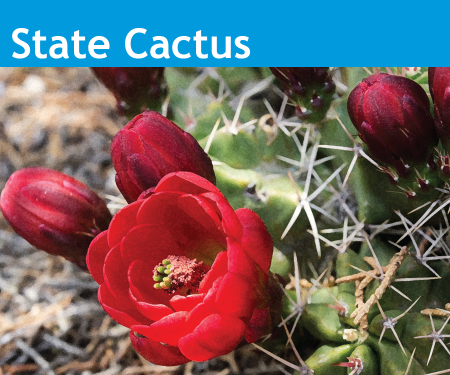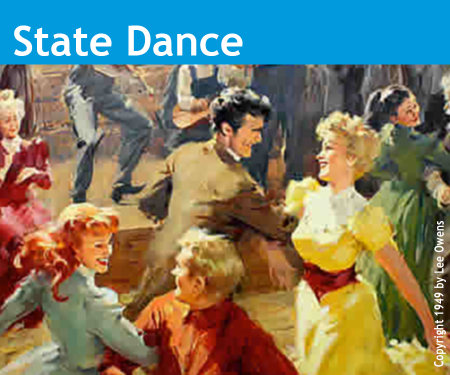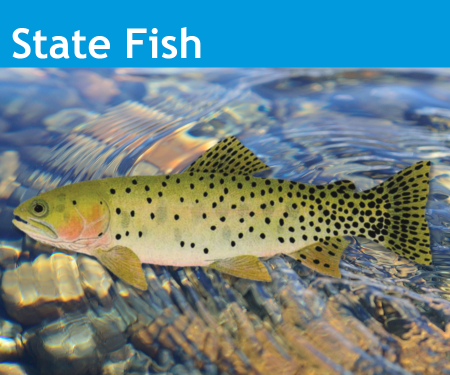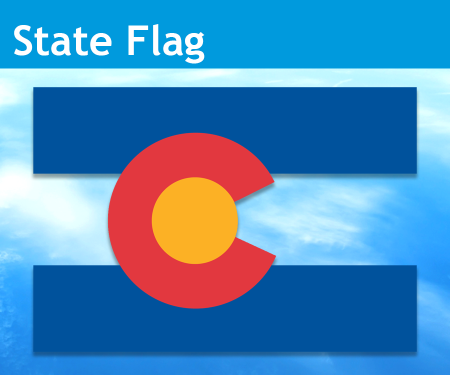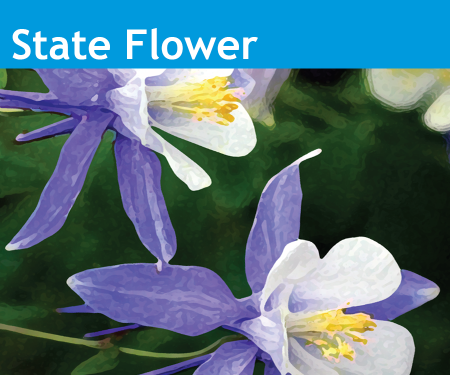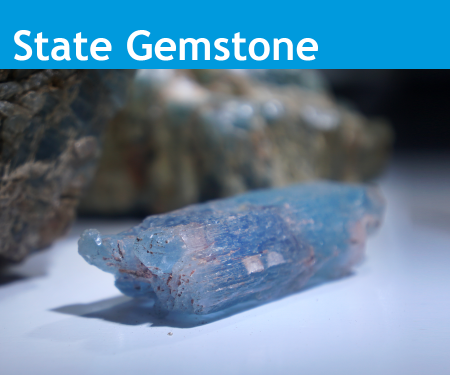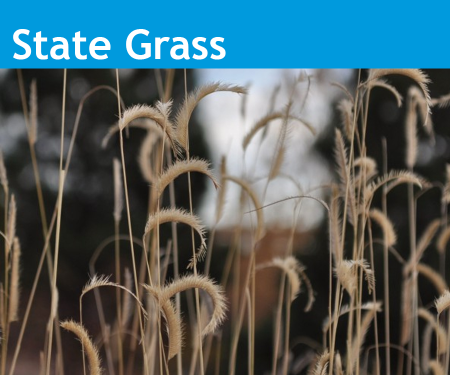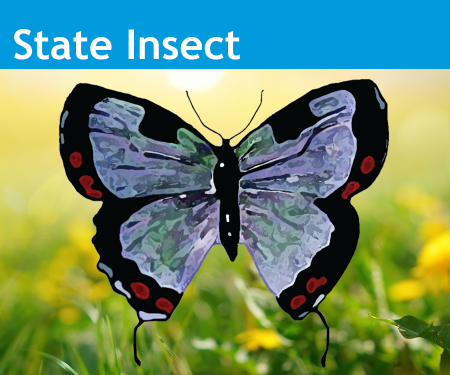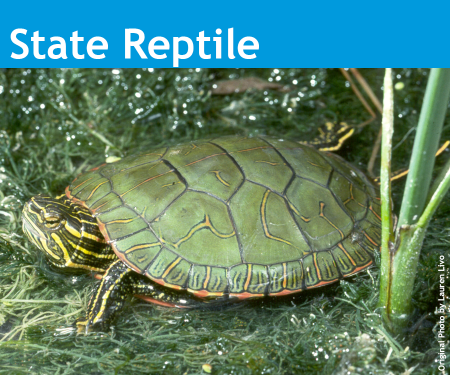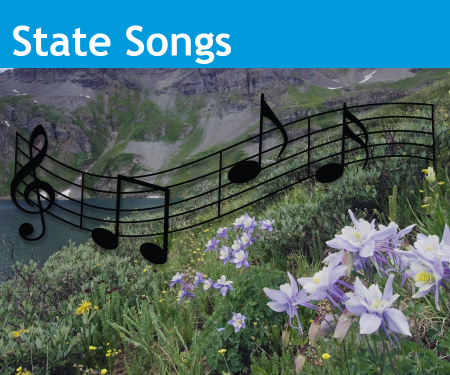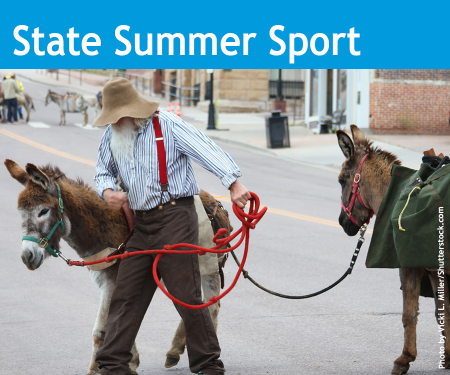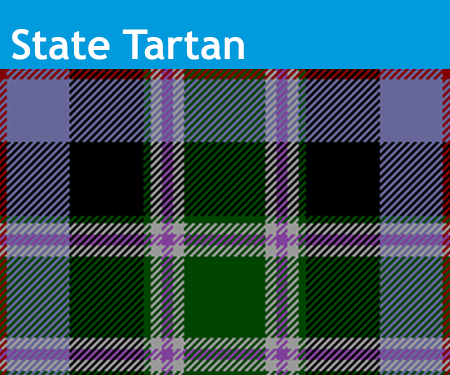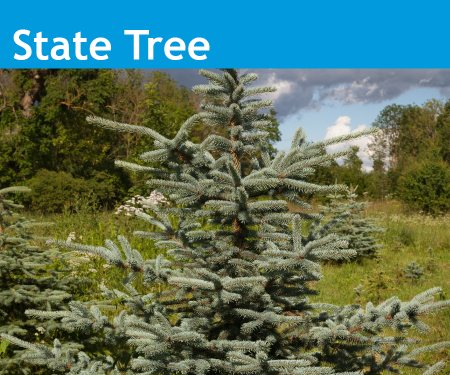Symbols & Emblems
Colorado's name has its origin in the Spanish language, as the word for "colored red." The name was chosen for Colorado as a Territory in 1861 by Congress and became a state in 1876. With statehood being 100 years after the signing of the nation's Declaration of Independence, Colorado's nickname became the "Centennial State." Colorado is also called "Colorful Colorado," presumably because of our magnificent scenery of mountains, rivers, and plains. This phrase has decorated maps, car license plates, tourist information centers, and souvenirs of all kinds!
As Colorado became a state on August 1, 1876, "Colorado Day" was born. State government and Coloradans celebrate the anniversary of statehood on the first of August each year with various events and activities.
Colorado's Motto, "Nil Sine Numine," is Latin for "Nothing without Providence or Deity." This phrase appears in the ribbon on the State Seal.
Colorado has an official state flag, a state seal, two state songs and many official emblems and symbols. These have been officially adopted by legislative action of the Colorado General Assembly or by executive order of the Governor of Colorado. The official designation of several of our symbols and emblems came to light by the participation of Colorado school children and their teachers in the legislative process.
State Symbols & Emblems
- Western Tiger Salamander
-
The Western Tiger Salamander (Ambystoma Mavortium), adopted March 16, 2012, is the official state amphibian, House Bill 12-1147. Governor Hickenlooper signed the bill due to the student's efforts from Steck and Westerly Creek Elementary, the Bill Roberts K-8 School, George Washington High School, and Stanley British Primary School.
Color ranges from light olive or brown to nearly black, often with yellow blotches or streaks on back and sides — belly is dull lemon yellow with irregular black spots. Adults range up to nine inches, including the tail. They spend most of summer and winter in the burrows of other animals or in some similar humid situation where they can keep their skin moist. They only emerge at night and are more active in spring and fall.
- Rocky Mountain Bighorn Sheep
-
The Rocky Mountain Bighorn Sheep (Ovis canadensis), adopted May 1, 1961, is the official state animal, Senate Bill 294, 1961; Colorado Revised Statute 24-80-911.
These animals are indigenous to the Rocky Mountains and live above timberline in rocky crags and high valleys. Bighorn sheep were named because of their massive horns, which curve backward from the forehead, down, then forward. On the ram/male, the horns can be as much as fifty inches in length. The male sheep weighs up to three hundred pounds, while the female is slightly smaller. These large animals are known for their agility and perfect sense of balance. It is unlawful to pursue, take, hunt, wound, or kill the Rocky Mountain Bighorn Sheep except as provided by law.
- Lark Bunting
-
The Lark Bunting (Calamospiza melanocoryus Stejneger), adopted April 29, 1931 (House Bill 222, 1931; Colorado Revised Statute 24-80-910), is the official state bird.
They sing a varied and pleasant song while in flight. The male bird is black with snowy white wing patches/edgings, tail coverts, and outer tail feathers. Male birds change to a gray-brown like the female in the winter. However, the chin remains black, and the black belly feathers retain white edgings. The female bird is gray-brown above and white below with dusky streaks. The male bird is six to seven inches, while the female is slightly smaller. The male bird performs a spectacular courtship flight, during which he warbles and trills a distinctive mating song. Flocks arrive in April and inhabit the plains regions and areas up to 8,000 feet in elevation. They fly south again in September.
- Claret Cup Cactus
The Claret Cup Cactus (Echinocereus triglochidiatus/Kingcup), adopted August 6, 2014, is the official state cactus, passed due to the efforts of four girls from the Douglas County Girl Scout Troop 2518 in Castle Rock, Colorado, House Bill 14-1024 (PDF).
The Claret Cup Cactus contains bright red-orange flowers that grow in clumps as much as 3-4 feet across, usually smaller, and often cover the whole plant, which is cylindrical and low-growing up against a larger plant. The flowers grow evenly at the tops of the stems and last for several days.
- Folk/Square Dance
-
The Square Dance was adopted as the official state folk dance on March 16, 1992 by an act of the General Assembly. House Bill 1058, 1992; Colorado Revised Statute 24-80-909.5.
Square dancing, standing in square formation of four couples or groups of four couples, is the American folk dance which traces its ancestry to the English country dance and the French ballroom dance, and which is called, cued, or prompted to the dancers and includes squares, rounds, clogging, contra, line, the Virginia Reel, and heritage dances.
- Greenback Cutthroat Trout
-
The Greenback Cutthroat Trout was adopted as the official state fish on March 15, 1994, by an act of the General Assembly, House Bill 1164, 1994; Colorado Revised Statute 24-80-911.5.
The Rainbow Trout was considered the state fish from 1954 until 1994; however, it was never officially adopted. The Greenback Cutthroat Trout was at one time indigenous to many small creeks, streams, and rivers throughout most of Colorado.As mining and human occupation expanded across the state, the greenback succumbed to pollution from mine tailings in streams and competition from other species of trout introduced to Colorado waters. The demise was so complete that up until the late 1980s, biologists feared the extinction of this native fish; however, researchers in the early 1990s discovered several small populations of the greenback in a few streams within Rocky Mountain National Park. The Colorado Division of Wildlife and National Park reintroduced this colorful fish to other waters within the state for its repopulation.
- Flag
-
The flag was adopted on June 5, 1911, by an act of the General Assembly and to be used on all occasions when Colorado is officially and publicly represented, with the privilege of use by all citizens upon occasions as they deem fitting and appropriate. Senate Bill 118, 1911; Senate Bill 152, 1929; Senate Bill, 1964. Laws pertaining to the use of the National flag are also applicable to the use of the State flag.
The flag embodies the colors of the National flag, the blue of Colorado skies, the gold of her metal, the white of mountain snows, and the red of soil. On August 1, 1876, Colorado became the 38th State to enter the Union under the flag of the United States.
The flag consists of three alternate stripes of equal width, and at right angles to the staff, the two outer stripes to be blue of the same color as in the blue field of the National flag and the middle stripe to be white, the proportion of the flag is a width of two-thirds of its length. At a distance, a circular red C, of the same color as the red in the National flag of the United States, is visible from the staff end of the flag to one-fifth of the total length of the flag. The diameter of the letter is two-thirds of the width of the flag. The inner line of the opening of the letter C is three-fourths of the width of its body or bar, and the outer line opening is double the length of the inner line thereof. Filling the open space inside the letter C is a golden disk, and attached to the flag is a cord of gold and silver intertwined with tassels, one of gold and one of silver.
The flag, originally designed by Andrew Carlisle Johnson, included precise colors of red and blue but was not designated in the 1911 legislation due to some controversy over those colors.
On February 28, 1929, the General Assembly stipulated the precise red and blue, the same colors as the National flag. Controversy also arose over the size of the letter C in March 1964, and the General Assembly further modified the 1911 legislation by revising the distance from the staff for the letter C and its diameter.
- Columbine
-
The white and lavender Columbine was declared the official state flower on April 4, 1899, by an act of the General Assembly. Senate Bill 261, 1899, Bill, 1925; Colorado Revised Statutes 24-80-905 through 24-80-908.
In 1925, the General Assembly made it the duty of all citizens to protect this rare species from needless destruction or waste. The law prohibits digging or uprooting the flower on public lands and limits the gathering of buds, blossoms, and stems to 25 in one day. It is unlawful to pick Columbine on private land without the consent of the landowner.
- Stegosaurus
-
The Stegosaurus was designated as the official state fossil on April 28, 1982, by the Executive Order of Governor Richard D. Lamm. A fourth-grade class campaigned across the state for two years to designate Stegosaurus as a Colorado symbol.
The Stegosaurus lived in the area we now know as Colorado one hundred and fifty million years ago during the Mesozoic era in the Jurassic period. It is believed that a typical Stegosaurus weighed ten tons though its brain weighed only two and one-half ounces. There are only six skeletons of the Stegosaurus on public display in the United States, one of which may be viewed at the Museum of Natural History in Denver - discovered by a teacher and students from Canon City High School.
- Aquamarine
-
Aquamarine was adopted as the official state gemstone on April 30, 1971, by an act of the General Assembly. House Bill 1104, 1971; Colorado Revised Statute 24-80-912.
The mountain peaks of Mount Antero and White Mountain in Colorado are among the finest quality localities known for gem aquamarine. They are also among the highest in elevation, located at 14,000 feet. These peaks contain gem-quality aquamarine crystals found in large miarolitic cavities. The crystals in these cavities range in color from light blue to pale and deep aquamarine green, in size from very small to 6 cm in length.
- Blue Grama
-
Blue Grama grass was adopted as the official state grass on May 20, 1987, by a resolution of the General Assembly, Senate Joint Resolution 13, 1987.
Blue Grama is a long-lived, warm-season perennial native grass thriving in Colorado, growing throughout many of the state's life zones on both sides of the Continental Divide. Blue Grama is a significant resource to Colorado's prairies because its dense, shallow root mass holds down the soil, keeping it from blowing away. The state grass was designated to help inform and educate citizens and tourists about this resource.
- Colorado Hairstreak Butterfly
-
The Colorado Hairstreak Butterfly was adopted as the official state insect on April 17, 1996, Senate Bill 122, 1996; Colorado Revised Statute 24-80-913.
The Colorado Hairstreak measures less than two inches wide, has purple wings with black borders, orange accents in the corners, and blue on the underside with a slender tail protruding from the hind wings. It may be found on both sides of the Continental Divide in hills and canyons of 6,500 to 9,000 in elevation in its usual habitat of scrub oak ecosystems. Adults congregate in larger numbers between July and August and only have one generation per year. Males are territorial and locate the females by their purple coloration.
- Rhodochrosite
-
On April 17, 2002, Colorado Governor Bill Owens signed a bill passed by the General Assembly designating the Rhodochrosite as the new state mineral.
Rhodochrosite's deep red to rose pink manganese carbonate (MnCO3) mineral is associated internationally with the state more than any other mineral, making it the official choice. However, some debate occurred whether the state mineral should be gold or silver or another mined mineral historically associated with Colorado. The world's largest Rhodochrosite crystal specimen, Alma King, was found in the Sweet Home Mine (originally a silver mine) near Alma (Park County), Colorado. Many of the crystal specimens produced at the mine are in museums, schools, and private collections, worldwide.
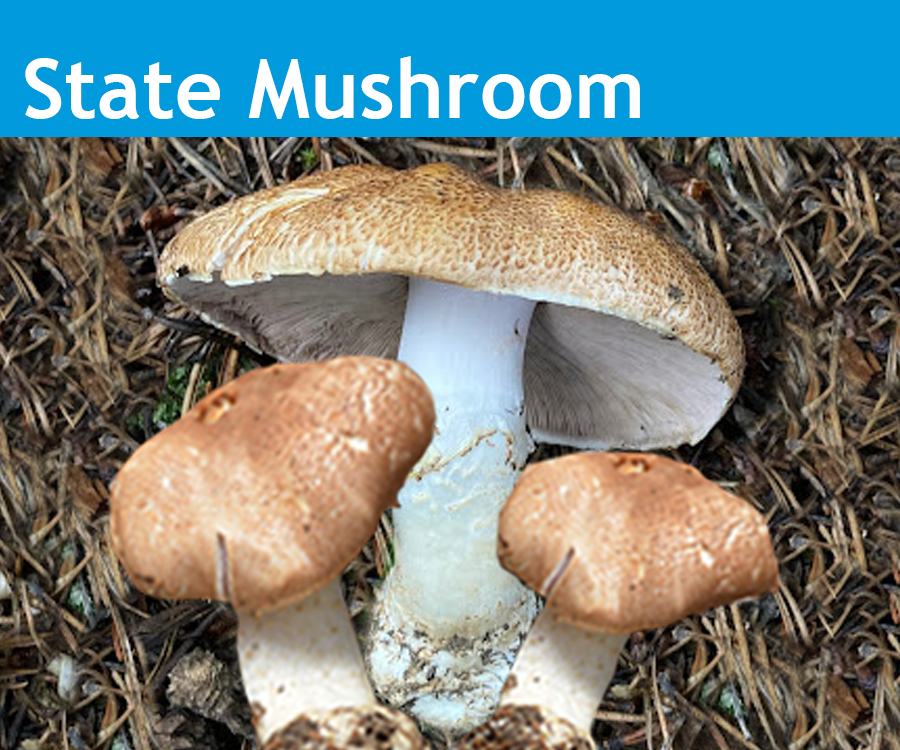
- Emperor Mushroom
HB25-1091 - Designation of State Mushroom, sponsored by Representative Jacque Phillips and Senator Kyle Mullica.
March 31, 2025, the Agaricus Julius, or the Emperor Mushroom, formerly known as Prince, was declared the official state mushroom, by Governor Jared Polis. The Emperor Mushroom is edible, has a large cap adorned with brown scales, and an odor reminiscent of almonds. It is found in the Rocky Mountains of Colorado.
- Dogs & Cats
Dogs and cats that are adopted from Colorado animal shelters and rescues are declared as the Colorado state pet. Governor Hickenlooper signed SENATE BILL 13-201 (PDF) on May 13, 2013, and the Bill took effect on August 7, 2013.
The Governor stated, "the Bill helps schoolchildren learn about the legislative process and that these pets become a huge part of people's lives."
- Western Painted Turtle
In March 2008, the Western Painted Turtle was adopted as Colorado’s official state reptile thanks to a group of determined Skyline Vista fourth grade Elementary School students, the state legislature, and Governor Bill Ritter, HB 08-1017.
In 2007, the students realized that Colorado lacked an official state reptile and researched Colorado reptiles. They decided that the Western Painted Turtle was most representative of Colorado reptiles. The turtle (Chrysemys picta bellii) is a common sight around many Colorado ponds and lakes.
- Yule Marble
The Yule Marble was designated as the Colorado State Rock by Governor Owens in 2004. HB04-1023 was signed into law on March 9, 2004, following a petition to the Legislature from the Lakewood Girl Scout Troop 357.
This white marble is comprised of almost pure calcite grains tightly joined to give it a luminous quality. A marble deposit was reported in 1882 in Gunnison County on Yule Creek, although a producing quarry did not begin operations there until 1906. The outstanding quality of the Yule Marble made it the choice for use in the basement of the Colorado Capitol, as well as numerous national monuments in the United States, including the Washington Monument, the Lincoln Memorial, and the Tomb of the Unknown Soldier.
- State Songs
There are two official state songs: “Where the Columbines Grow,” by A.J. Fynn, adopted 1915 and “Rocky Mountain High,” adopted 2007.
"Where the Columbines Grow" by A.J. Fynn, 1915 — Adopted as the official state song on May 8, 1915, by an act of the General Assembly, Senate Bill 308, 1915; Colorado Revised Statute 24-80-909.
A.J. Fynn wrote the words for the song and composed the music, and dedicated the song to the Colorado pioneers. As Fynn traveled by horse and wagon to visit Indian tribes in the San Luis Valley in 1896, the inspiration to write it came after coming across a beautiful Colorado mountain meadow covered with columbines.Sheet music may be ordered through retail music stores and is not available from the State of Colorado.
Verse One
Where the snowy peaks gleam in the moonlight, Above the dark forests of pine, And the wild foaming waters dash onward, Toward lands where the tropic stars shine; Where the scream of the bold mountain eagle Responds to the notes of the dove Is the purple robed West, the land that is best, The pioneer land that we love.Chorus
Tis the land where the columbines grow, Overlooking the plains far below, While the cool summer breeze in the evergreen trees Softly sings where the columbines grow.Verse Two
The bison is gone from the upland, The deer from the canyon has fled, The home of the wolf is deserted, The antelope moans for his dead, The war whoop re-echoes no longer, The Indian's only a name, And the nymphs of the grove in their loneliness rove, But the columbine blooms just the same.Verse Three
Let the violet brighten the brookside, In sunlight of earlier spring, Let the fair clover bedeck the green meadow, In days when the orioles sing, Let the golden rod herald the autumn, But, under the midsummer sky, In its fair Western home, may the columbine bloom Till our great mountain rivers run dry.-------
"Rocky Mountain High" by John Denver (lyrics) and Mike Taylor (music) 1973 — Adopted as another State Song with the passage of SJR07-023 on March 12, 2007. After the song's release in 1973, there was some controversy as some people thought it encouraged drug use. Denver, in 1985, responded by saying that these people had obviously never experienced the beauty and wonder of the Rocky Mountains. Denver's real name was Henry John Deutschendorf Jr. but his stage name came from the capital city of Colorado.
Verse One
He was born in the summer of his 27th year, coming home to a place he'd never been before. He left yesterday behind him you might say he was born again, might say he found a key for every door. When he first came to the mountains His life was far away on the road and hanging by a song. But the string's already broken and he doesn't really care, it keeps changin' fast, and it don't last for long.Chorus
It's a Colorado Rocky Mountain High, I've seen it raining fire in the sky The shadows from the starlight are softer than a lullabye. Rocky Mountain High, ...in Colorado.... Rocky Mountain High.Verse Two
He climbed cathedral mountains, he saw silver clouds below, saw everything as far as you can see. And they say that he got crazy once and that he tried to touch the sun, and he lost a friend, but kept the memory. Now he walks in quiet solitude, the forest and the stream, seeking grace in every step he takes, his sight is turned inside himself, to try and understand, the serenity of a clear blue mountain lake.Chorus
And the Colorado Rocky Mountain High, I've seen it raining fire in the sky. You can talk to God and listen to the casual reply. Rocky Mountain High, ....in Colorado.... Rocky Mountain High.Verse Three
Now his life is full of wonder, but his heart still knows some fear, of the simple things he can not comprehend. Why they try to tear the mountains down to bring in a couple more. More people, more scars upon the land.Chorus
It's the Colorado Rocky Mountain High, I've seen it raining fire in the sky. I know he'd be a poorer man if he never saw an Eagle fly. Rocky mountain high It's the Colorado Rocky Mountain High, I've seen it raining fire in the sky. Friends around the camp fire and everybody's high.... Rocky Mountain High, Rocky Mountain High, Rocky Mountain High, Rocky Mountain High.
- Great Seal
The Great State Seal of Colorado is an adaptation of the Territorial Seal, adopted by Joint Resolution of the First Territorial Assembly on November 6, 1861. The statutory provision for the official seal of statehood was provided for by an Act of the First General Assembly of the State of Colorado, approved on March 15, 1877.
The circular seal contains the Eye of God within a triangle. Below the triangle is a Roman fasces or scroll, the insignia of a republic form of government. The fasces is a bundle of birch or elm rods and a battle-ax. The bundle of rods symbolizes strength that is lacking in a single rod. The ax represents authority and leadership. "Union and Constitution" are written on the red, white, and blue bands surrounding the fasces. A heraldic shield lies below the scroll and bears three snowcapped mountains and mining tools. The seal also includes the Latin phrase "Nil Sine Numine," which means "Nothing without Providence (or Deity)," and the year that Colorado gained statehood, 1876.
The official colors of the seal, fixed by a 1976 Executive Order, are as follows:
Red: The sky behind the mountains, the single band with the word "UNION" and the ring containing the words "STATE OF COLORADO, 1876."
White: The snowcaps of the three mountains, the clouds surrounding the mountains, the band with the word "AND," the banner containing the words "NIL SINE NUMINE," the triangle of the Eye of God, the fasces, and innermost ring.
Dark Blue: The mountains, the background behind the shield, the single band with the word "CONSTITUTION," and the six stars dividing the year of statehood from the lettering "STATE OF COLORADO," the two dots separating the words "STATE OF COLORADO."
Gold: The Eye of God, the rays emanating from the Eye, the background in the lower shield, the small decorative circles on the innermost white ring, the ring situated between the red ring, and the outer silver ring of the seal.
Silver: The outside ring of the seal, the lettering "STATE OF COLORADO" and "1876," the ax head, the heads of both miner's tools, the two bands binding the fasces behind the two bands entitled "UNION" and "CONSTITUTION," the outline of the shield, and the dividing line between the upper and lower portions of the shield.
Brown: The handles of the miner's tools, the handle of the ax.
Black: The lettering of the words "UNION," "AND," and "CONSTITUTION," the words "NIL SINE NUMINE," the outline tracing the cascade of the banner containing the words "NIL SINE NUMINE," the outlines encircling the small decorative circles on the innermost white circle, and the outlines of the single band "AND."
- Pack Burro Racing
The Colorado General Assembly passed a resolution for an official state summer sport and adopted pack burro racing as the official summer heritage sport in Colorado in 2012. House Joint Resolution 12-1021 (PDF).
Sources from the StateSymbolsUSA.org share that two miners found gold in the Rocky Mountains and raced each other back to town to be the first to stake a claim to the find. Neither miner could ride their animal because of its load, and so they ran alongside their burros.
Based on stories such as these, and in the spirit of carrying on the traditions of Colorado's early citizens, the sport of pack burro racing was born, with the first official event between Leadville and Fairplay organized in 1949.
An individual runs alongside and leads their burro, which is weighed down by a thirty-three-pound pack. There are currently organized pack burro racing events in Idaho Springs, Georgetown, Buena Vista, Leadville, and Fairplay. Each event is part of a festival celebrating the town's history.
Colorado pack burro racing has a Triple Crown, requiring a racer to win all three consecutive pack burro events in Fairplay, Leadville, and Buena Vista. The race held in Fairplay, Colorado, is 29 miles in length and counts as an ultra-marathon.
- Patterns and Colors
The Colorado General Assembly passed a resolution adopting an official state tartan on March 3, 1997. July 1 is designated as "Tartan Day" in Colorado under House Joint Resolution 96-1014. National Tartan Day is April 6.
The tartan is comprised of a pattern and colors that symbolize Colorado's splendor and history. The pattern/sett consists of primary blocks of forest green and cerulean blue separated by broad dividing bands of black with the forest green checks containing two pairs of tram tracks consisting of lavender and white with the cerulean blue checks containing a gold stripe with red guard lines.
The official state tartan is a Celtic and a "district" tartan that may be worn by any resident or friend of Colorado whether or not of Celtic heritage.
- Colorado Blue Spruce
The Colorado Blue Spruce, Picea pungens, was adopted as the official state tree on March 7, 1939, by a resolution of the General Assembly, House Joint Resolution 7, 1939.
Colorado school children voted on Arbor Day in 1892 to name the blue spruce as the state tree; however, it was not until 1939 that the Colorado Blue Spruce was officially designated.
The Colorado Blue Spruce was first discovered on Pikes Peak in 1862 by botanist C.C. Parry. In 1879 it was named by George Engelmann. It is known for its stately, majestic, symmetrical form and beautiful silver-blue color growing in small, scattered groves or singly among ponderosa pine, Douglas fir, alpine fir, and Englemann spruce. Its color ranges from green to blue to silver and is sometimes called the silver spruce. It grows at the elevation range of 6,000 to 11,000 feet.
- Skiing and Snowboarding
April 8, 2008, by an act of the General Assembly, skiing and snowboarding were designated the official state winter sport.
There is no other winter sport that attracts more Coloradans and visitors to our great outdoor recreation. During a fourth-grade history class at Dennison Elementary in Lakewood, a 9-year-old had the idea to designate a winter sport. After 70 petitions, support from state Reps. Gwynn Green and Christine Scanlan, and voting by the House and Senate, a resolution passed, making skiing and snowboarding the official state winter sport and joined the prestigious official state symbols list.


